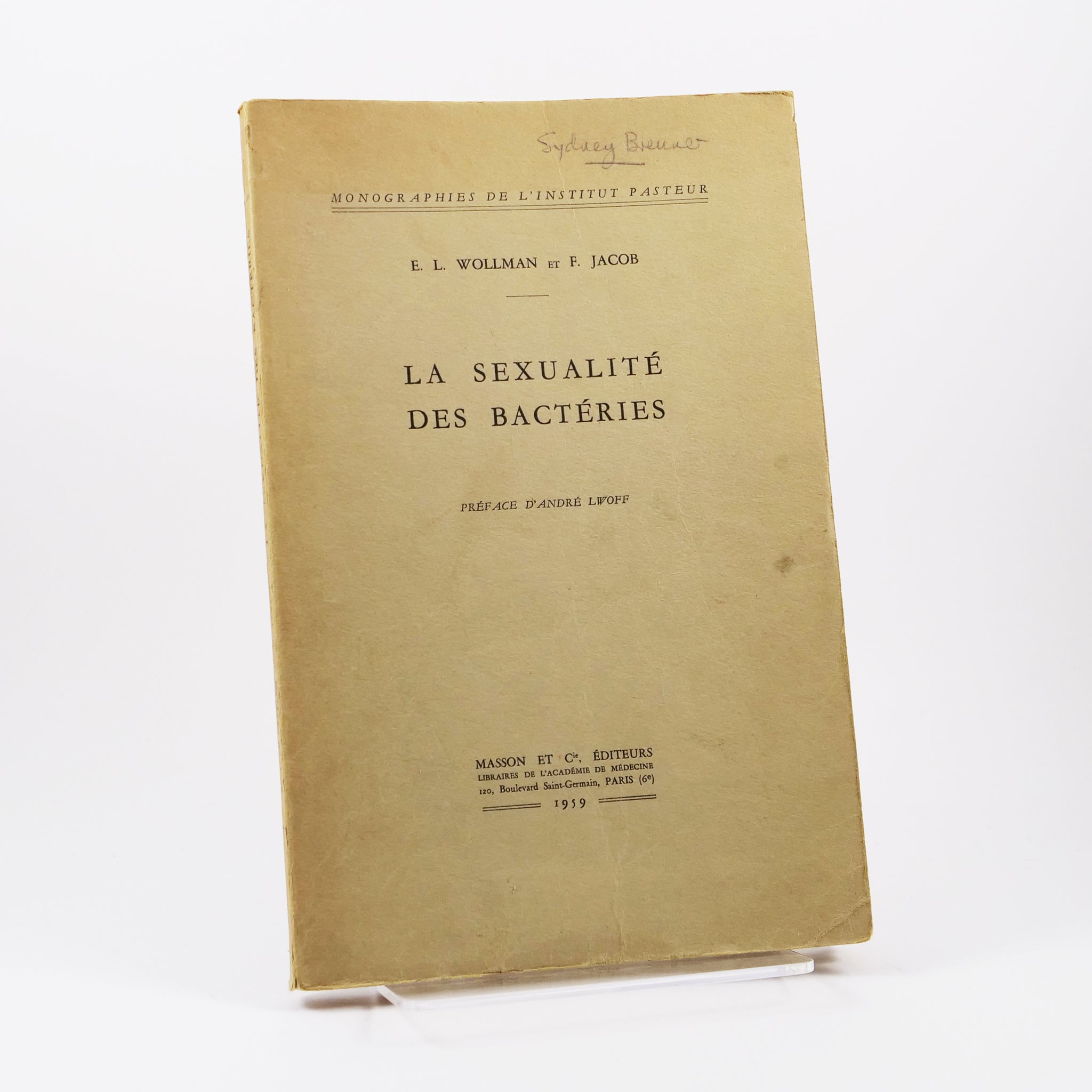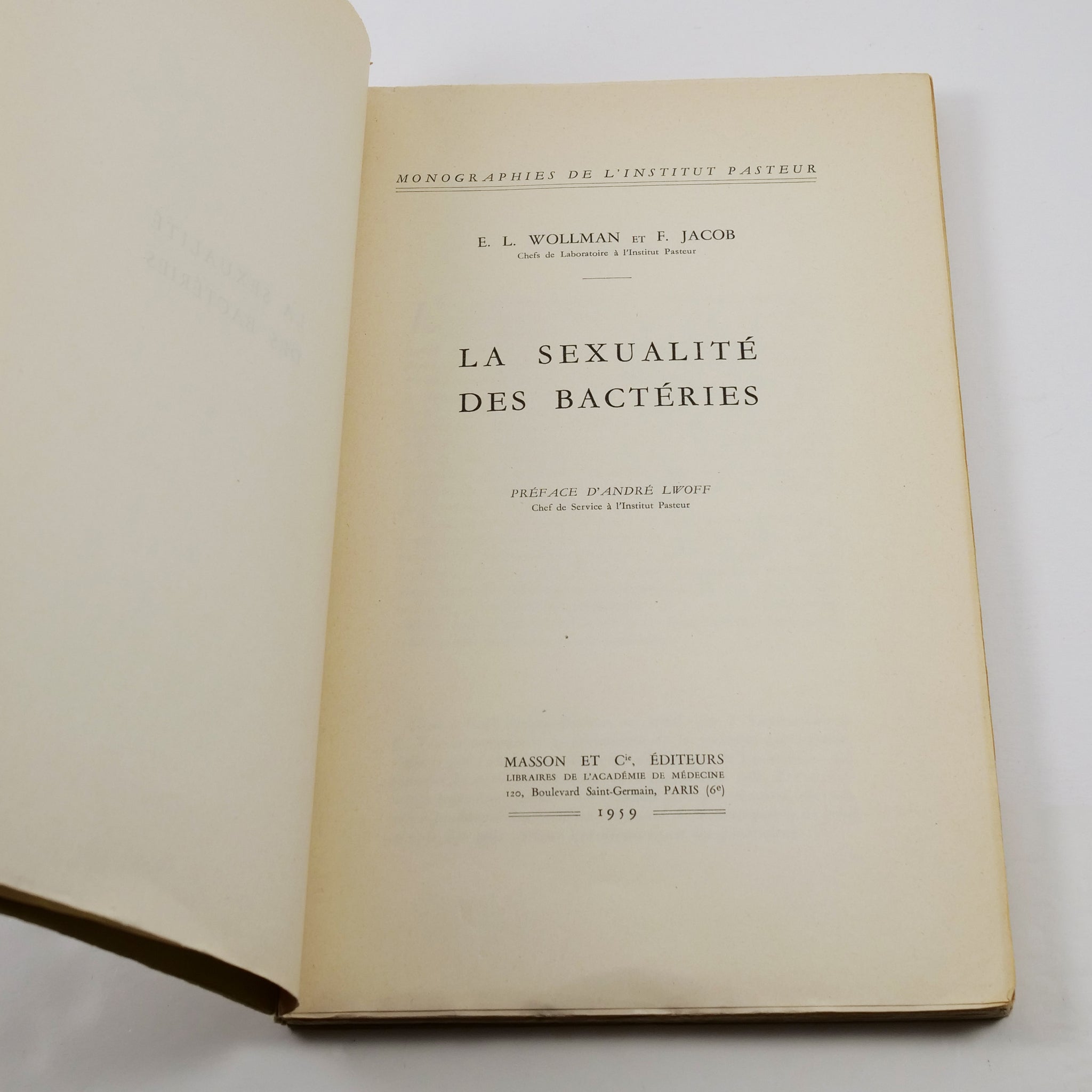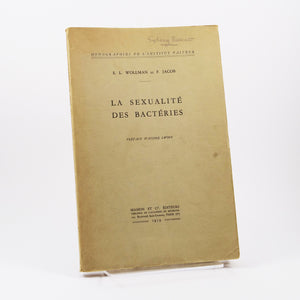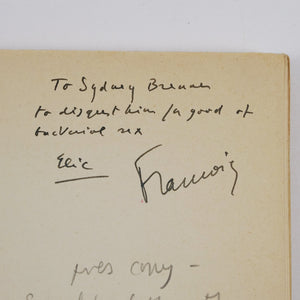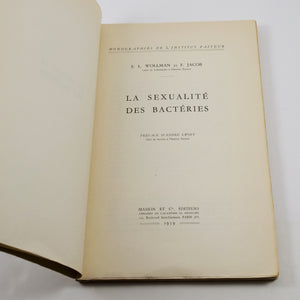(Brenner, Sydney) Wollman, E. L. & F. Jacob | La Sexualité des Bactéries
£4,750.00
-
First edition, first impression of this uncommon and important monograph on bacterial genetics. An exceptional presentation copy signed by author François Jacob, with whom Brenner would partner only a year later to perform one of the most elegant experiments in the history of biochemistry, proving the role of messenger RNA and elucidating a key mechanism in the cell’s process for decoding DNA. Cheekily inscribed by Jacob’s co-author, Elie Wollman (1917-2008), “To Sydney Brenner, to disgust him / a good of bacterial sex” (possibly missing the word “dose” or similar before “bacterial sex”). And with Brenner’s ownership signature in pencil on the upper cover.
Wollman and Jacob were bacteriologists at the Pasteur Institute who, by investigating bacterial reproduction, made groundbreaking discoveries in genetics. They published one of the first examples of a gene regulatory mechanism; discovered plasmids (portions of genetic material independent of the chromosomal DNA); and created the first model of gene mapping in a living organism” (Dantzer, “Elie Wollman 1917-2008: A Biographical Memoir, National Academy of Science, 2008). The present volume covers the breadth of contemporary knowledge of bacterial reproduction, including conjugation and the resulting genetic recombination. Jacob was later awarded the Nobel Prize for work on the regulation of enzyme levels in cells, and Wollman received several awards, including the French Legion of Honour.
Recipient Sydney Brenner (1927-2019) was a leader in the field of genetics almost from the moment he received his doctorate at Oxford in 1954. He joined Francis Crick’s Cambridge laboratory in 1956, and they performed innovative research on how DNA is decoded by cells. Brenner proposed that the nucleotides which comprise DNA (adenine, guanine, thiamine and cytosine) are read by the cell in groups of three called codons, with each codon representing an amino acid (for example, three adenines in a row is the codon for the amino acid lysine). A gene is therefore a string of codons that directs the production of a specific protein molecule from individual amino acids. He would later win the Nobel Prize for his work establishing the nematode c. elegans as a key model organism for genetics, neurobiology and developmental biology research.
Brenner met Jacob and Wollman at a symposium on microbial genetics in Copenhagen in 1959 (it was almost certainly on this occasion, or shortly afterwards, that this copy was presented), where Jacob hoped to discuss new evidence for the existence of an intermediary molecule responsible for transporting information from DNA in the nucleus to the site of protein production in cellular structures called ribosomes, located outside the nucleus. It was known that ribosomes contained an analogue to DNA, ribosomal nucleic acid (RNA), but it was not clear whether there were intermediaries between DNA and RNA. Though nothing concrete came of the Copenhagen symposium, the following spring Jacob again brought up the subject during a meeting with Brenner, Crick, and other biochemists at Cambridge. As Jacob later recalled, when he pointed out recent experimental results suggesting that, unlike normal RNA, the messenger molecule was unstable, “Francis and Sydney leaped to their feet. Began to gesticulate. To argue at top speed in great agitation. A red-faced Francis. A Sydney with bristling eyebrows. The two talked at once, all but shouting. Each trying to anticipate the other. To explain to the other what had suddenly come to mind” (Jacob, The Statue Within, p. 312). What Brenner and Crick had suddenly remembered was another experiment showing that when a certain virus attacked bacterial cells it blocked the creation of new ribosomes, and the only RNA then manufactured by the cell was both unstable and had the same base composition as DNA, strongly suggesting that it was the messenger molecule.
That afternoon Brenner and Jacob also learned that they had both been invited to spend the month of June as visiting scholars at Caltech, the perfect opportunity to collaborate and prove that there was an intermediary in the DNA decoding process and that it was the previously discovered unstable RNA. Most importantly, the colleague who had invited Jacob, Mat Meselson, had just developed a new method for marking bacterial macromolecules with heavy isotopes. Brenner and Jacob developed a plan “to distinguish whether, after phage (virus) infection, new RNA went to new ribosomes, or whether there were no new ribosomes, just the preexisting ones ‘for hire’ – Brenner’s phrase at the time – to the new message when it came along. So that old ribosomes could be labelled, the bacteria would be grown with heavy carbon and nitrogen, the bacteria switched to a broth containing normal, lighter isotopes and simultaneously infected with phage, and new RNA labelled with radiophosphorous. Then ribosomes would be separated from bacteria, put into a cesium-chloride solution, and spun at thirty-seven thousand revolutions per minute for thirty-six hours... in this enormous centrifugal force... the cesium chloride in the solution became distributed in a gradient that was denser towards the bottom of the tube; anything of like density in the tube would sink or float to the level that exactly corresponded with it. Thus, ribosomal particles grown heavy before infection would form a band farther down the centrifuge tube than any made after infection when the isotopic labels were light. Radioactivity could then be checked in each band of ribosomes” (Judson, The Eighth Day of Creation, p. 423).
With only four weeks to complete the experiment, Brenner and Jacob worked at speed and had to overcome numerous setbacks, from the difficulty of acquiring radioactive phosphorus to problems caused by a lack of magnesium in their culture medium. But the final result was “spectacular. Eyes glued to the Geiger counter, our throats tight, we tracked each successive figure as it came to take its place in exactly the order we had been expecting. And as the last sample was counted, a double shout of joy shook the basement at Caltech. Followed immediately by a wild double jig. This was merely one experiment, performed in extremis… But we now knew that we had won. That our conception explained the transfers of information in the synthesis of proteins… Scarcely was the experiment over than we gave a seminar at Caltech to demonstrate the existence of X and its role as magnetic tape. No one believed us. The next day we left, each to his own home. The bet had paid off. In the nick of time” (Jacob, p. 317).
-
Paris: Masson et Cie, Libraires de l’Académie de Médecine, 1959.
Octavo. Original grey wrappers printed in black. 3 double-sided plates from photographs. Wrappers rubbed, a little creased, and partially tanned with a few small spots and marks. Slight crease affecting the margins of the first half of the contents. A very good copy.

